What Does a KAP Survey Reveal about the Awareness Regarding Leishmaniasis among the Community of an Endemic Area in Sri Lanka?
Abstract
1. Background
Why a KAP Survey?
2. Methods
2.1. How Did It Go?
2.1.1. Selection of the Study Setting
2.1.2. Questionnaire Validation
2.1.3. Data Collection
2.1.4. Data Processing and Analysis
2.1.5. Ethical Consideration
3. Results
3.1. Whose Is This about?
3.2. What the KAP Survey Revealed?
3.2.1. Knowledge: How Much Do They Know?
What Do They Know about the Disease?
Do They Know the Vector of Leishmaniasis?
3.2.2. Attitudes: What Do They Think?
Attitudes towards Vector Control, Disease Control and Knowledge Sources
3.3. Practices: Are They Successful?
3.3.1. What Is Their Level of Vector Control Practices?
3.3.2. What about the Level of Disease Control Practices?
3.3.3. What Does the Inferential Study Say?
4. Discussion
What Are the Challenges? Limitations of the Research
5. Conclusions
Supplementary Materials
Author Contributions
Funding
Institutional Review Board Statement
Informed Consent Statement
Data Availability Statement
Acknowledgments
Conflicts of Interest
References
- Mann, S.; Frasca, K.; Scherrer, S.; Henao-Martínez, A.F.; Newman, S.; Ramanan, P.; Suarez, J.A. A Review of Leishmaniasis: Current Knowledge and Future Directions. Curr. Trop. Med. Rep. 2021, 8, 121–132. [Google Scholar] [CrossRef] [PubMed]
- Arenas, R.; Torres-Guerrero, E.; Quintanilla-Cedillo, M.R.; Ruiz-Esmenjaud, J. Leishmaniasis: A review. F1000Research 2017, 6, 1–15. [Google Scholar] [CrossRef]
- Centers for Disease Control and Prevention. Leishmaniasis—Epidemiology & Risk Factors; CDC: Atlanta, GA, USA, 2013. [Google Scholar]
- Alvar, J.; Yactayo, S.; Bern, C. Leishmaniasis and poverty. Trends Parasitol. 2006, 22, 552–557. [Google Scholar] [CrossRef] [PubMed]
- Karunaweera, N.D.; Pratlong, F.; Siriwardane, H.V.Y.D.; Ihalamulla, R.L.; Dedet, J.P. Sri Lankan cutaneous leishmaniasis is caused by Leishmania donovani zymodeme MON-37. Trans. R. Soc. Trop. Med. Hyg. 2003, 97, 380–381. [Google Scholar] [CrossRef] [PubMed]
- Siriwardana, H.; Chandrawansa, P.; Sirimanna, G.; Karunaweera, N. Leishmaniasis in Sri Lanka: A decade old story. Sri Lankan J. Infect. Dis. 2012, 2, 2–12. [Google Scholar] [CrossRef]
- Amarasinghe, A.; Wickramasinghe, S. A Comprehensive Review of Cutaneous Leishmaniasis in Sri Lanka and Identification of Existing Knowledge Gaps. Acta Parasitol. 2020, 65, 300–309. [Google Scholar] [CrossRef] [PubMed]
- Siriwardana, H.V.Y.D.; Thalagala, N.; Karunaweera, N.D. Clinical and epidemiological studies on the cutaneous leishmaniasis caused by Leishmania (Leishmania) donovani in Sri Lanka. Ann. Trop. Med. Parasitol. 2010, 104, 213–223. [Google Scholar] [CrossRef] [PubMed]
- Chappuis, F.; Sundar, S.; Hailu, A.; Ghalib, H.; Rijal, S.; Peeling, R.W.; Alvar, J.; Boelaert, M. Visceral leishmaniasis: What are the needs for diagnosis, treatment and control? Nat. Rev. Microbiol. 2007, 5, 873–882. [Google Scholar] [CrossRef] [PubMed]
- Elfil, M.; Negida, A. Sampling methods in clinical research; an educational review. Arch. Acad. Emerg. Med. 2019, 7, 3–5. [Google Scholar]
- Gupta, S.; Sharma, S.; Gohil, R.; Sachdeva, S. Epicollect5: A Free, Fully Customizable Mobile-based Application for Data Collection in Clinical Research. J. Postgrad. Med. Educ. Res. 2021, 54, 248–251. [Google Scholar] [CrossRef]
- Kotler, F. Kotler on Marketing: How to Create, Win, and Dominate Markets; Alpina Business Books: Moscow, Russia, 2008; 283p. (In Russian) [Google Scholar]
- Guetterman, T.C. Basics of statistics for primary care research. Fam. Med. Community Health 2019, 7, 1–7. [Google Scholar] [CrossRef] [PubMed]
- Boutayeb, A. Developing countries and neglected diseases: Challenges and perspectives. Int. J. Equity Health 2007, 6, 4–7. [Google Scholar] [CrossRef] [PubMed]
- Wijerathna, T.; Gunathilaka, N.; Gunawardana, K.; Rodrigo, W. Potential Challenges of Controlling Leishmaniasis in Sri Lanka at a Disease Outbreak. Biomed Res. Int. 2017, 2017, 6931497. [Google Scholar] [CrossRef] [PubMed]
- Yasuoka, J.; Levins, R.; Mangione, T.W.; Spielman, A. Community-based rice ecosystem management for suppressing vector anophelines in Sri Lanka. Trans. R. Soc. Trop. Med. Hyg. 2006, 100, 995–1006. [Google Scholar] [CrossRef] [PubMed]
- United Nations. Empowering Women by Creating Awareness. Available online: https://www.un.org/en/academic-impact/empowering-women-creating-awareness (accessed on 18 August 2023).
- Anker, M. Addressing Sex and Gender in Epidemic-Prone Infectious Diseases; World Health Organization: Geneva, Switzerland, 2007; pp. 1–46. [Google Scholar]
- Gerstl, S.; Amsalu, R.; Ritmeijer, K. Accessibility of diagnostic and treatment centres for visceral leishmaniasis in Gedaref State, northern Sudan. Trop. Med. Int. Health 2006, 11, 167–175. [Google Scholar] [CrossRef] [PubMed]
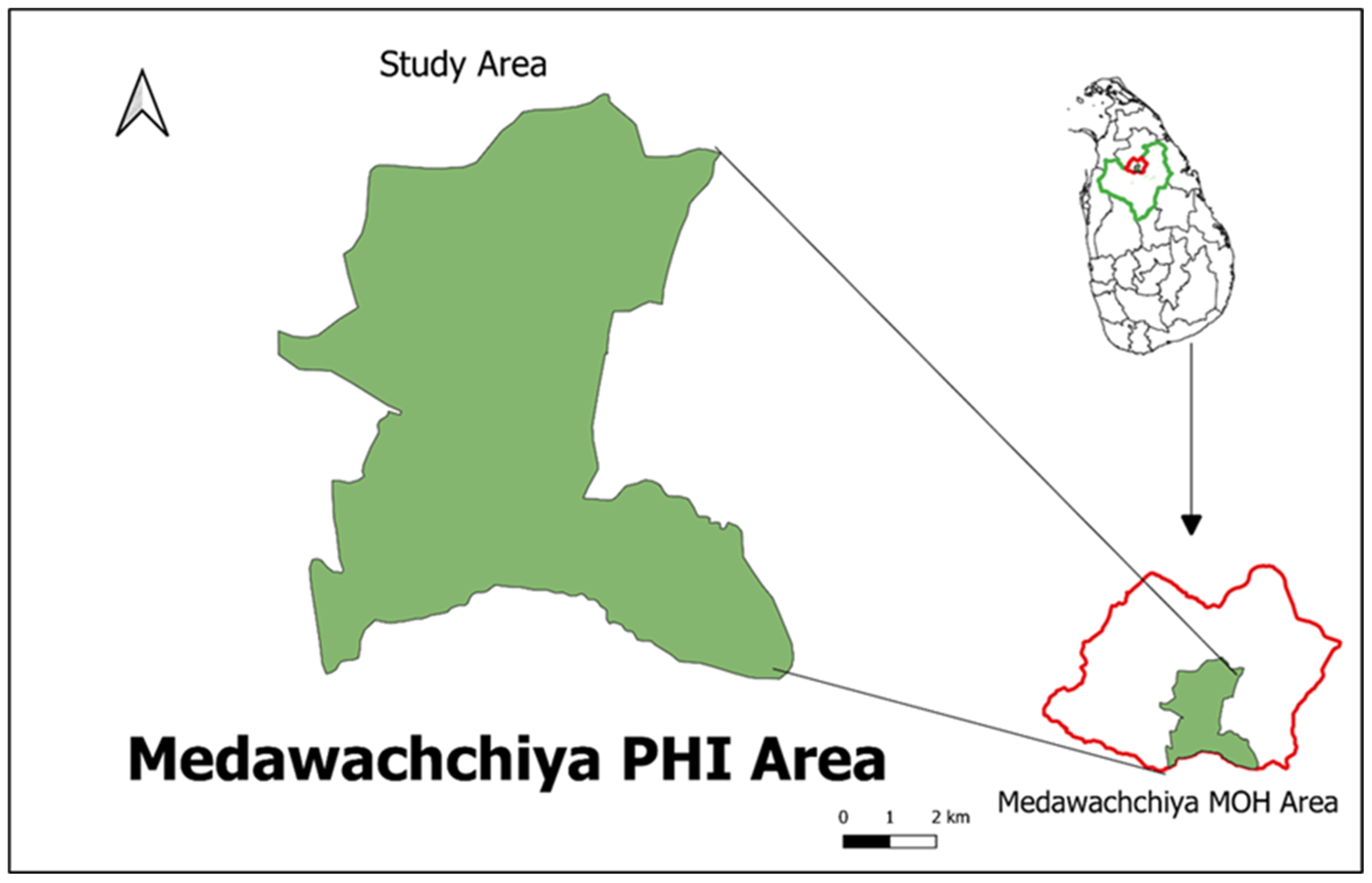
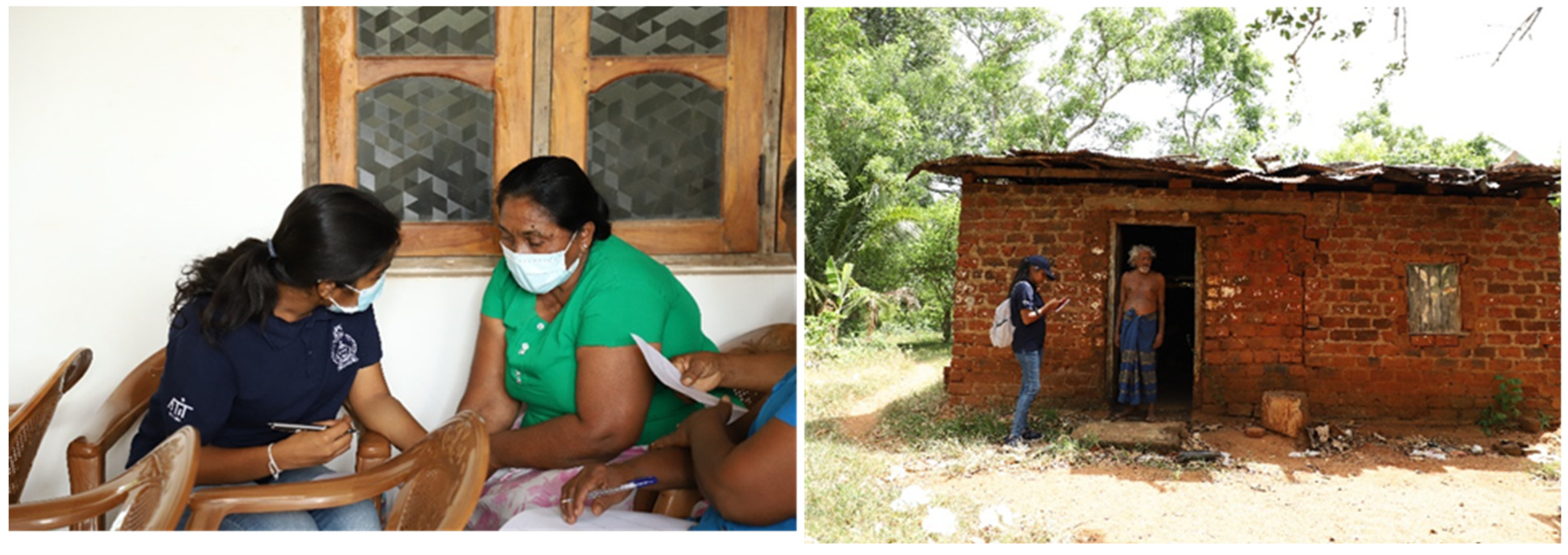
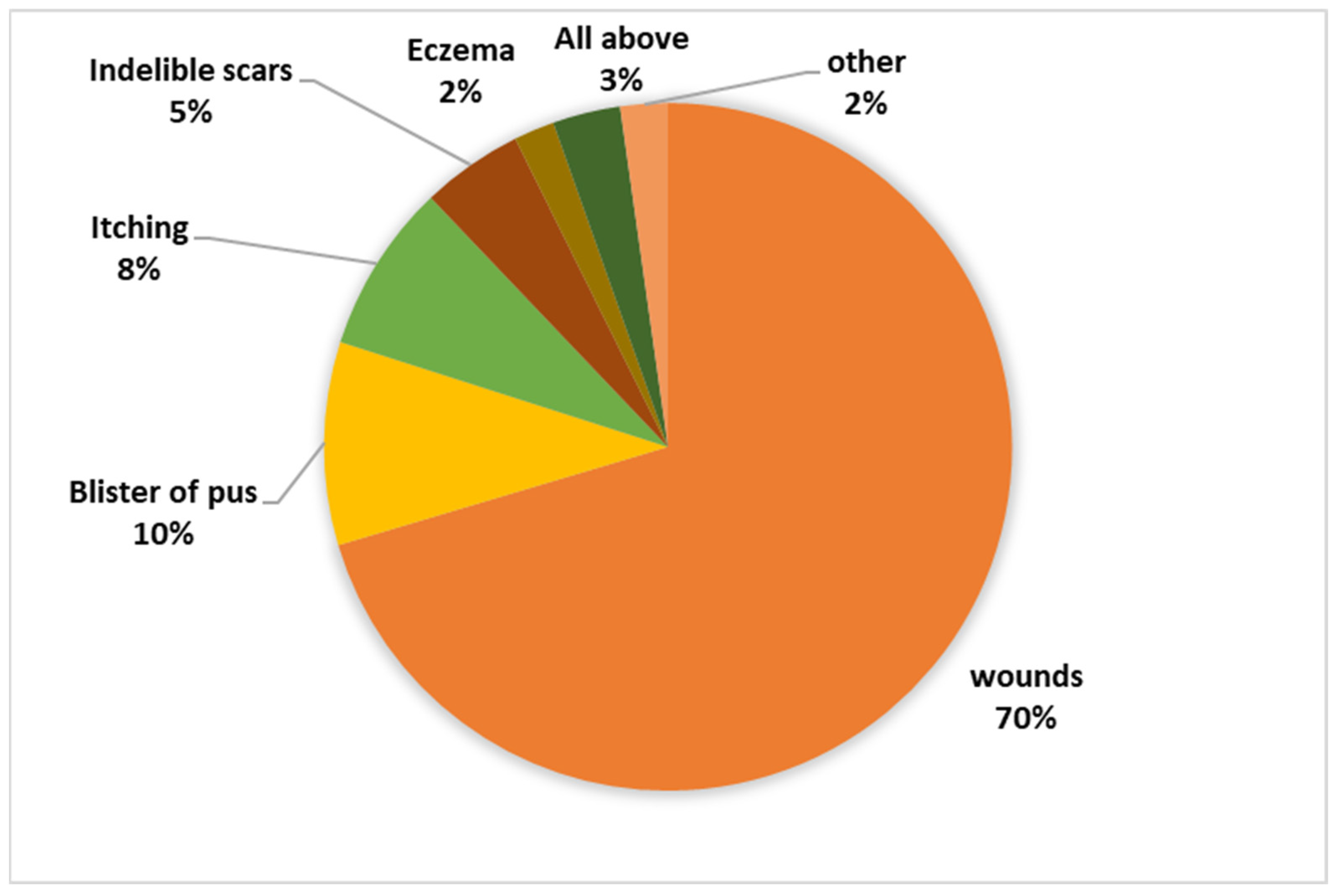
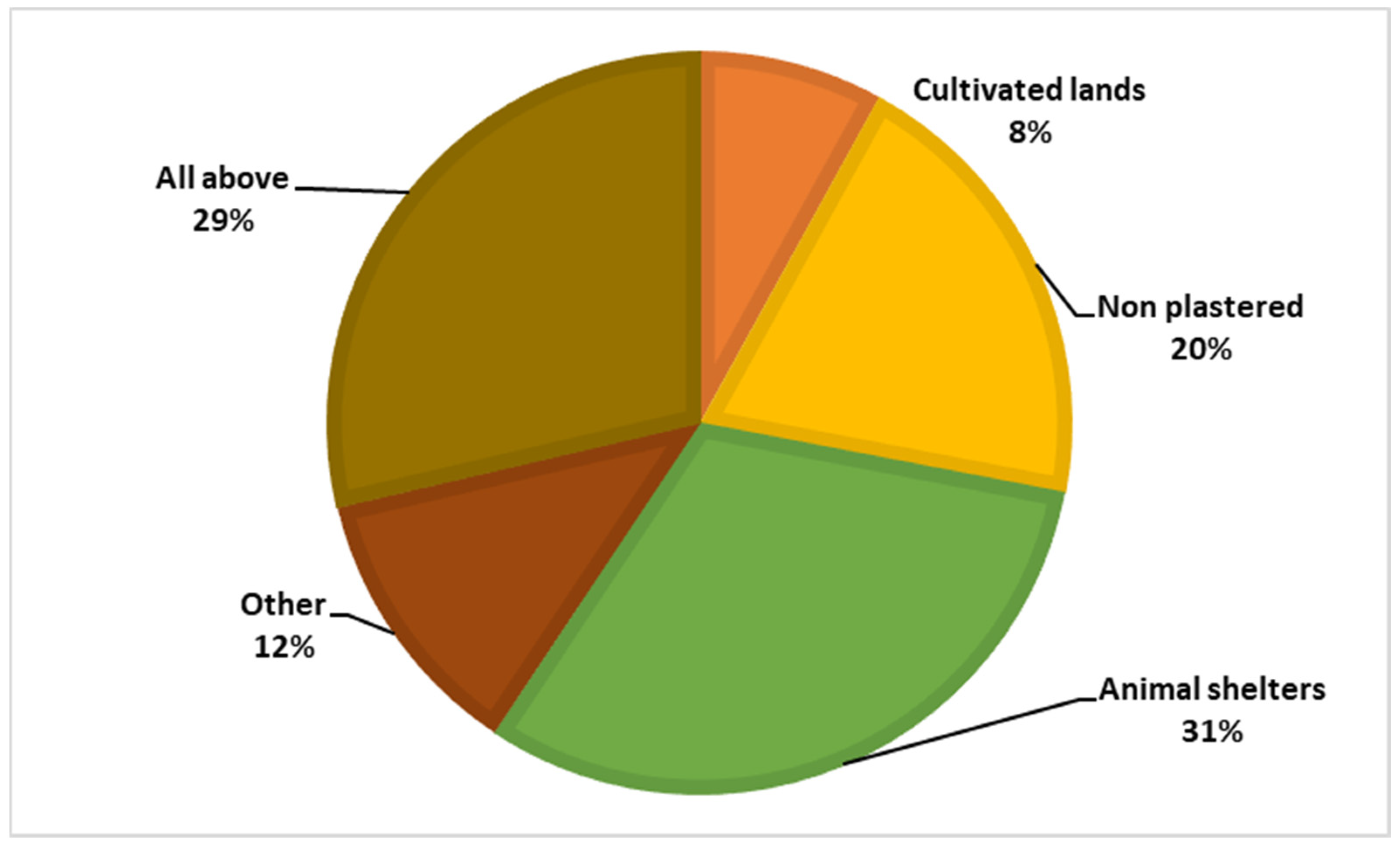
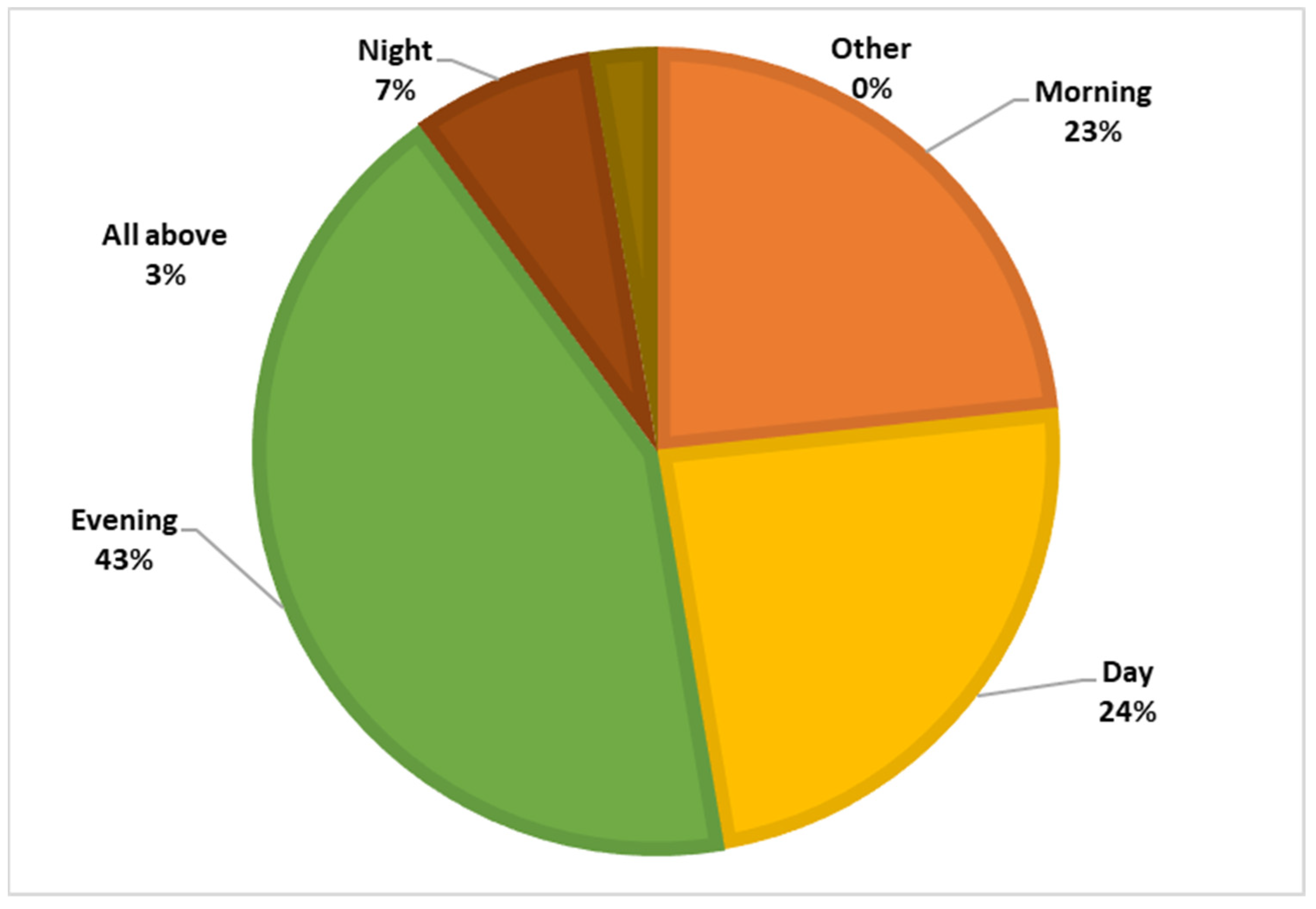
| Variable | N (%) | Variable | N (%) |
|---|---|---|---|
| Age (Mean ± SD) | 45.64 ± 13.81 | Education | |
| <18 years | 2 (0.7%) | No schooling | 174 (62.8%) |
| 18–33 years | 48 (17.3%) | Up to Grade 5 | 84 (30.3%) |
| 34–49 years | 126 (45.5%) | Up to Grade 9 | 19 (6.9%) |
| 50–65 years | 73 (26.4%) | ||
| >65 years | 28 (10.1%) | Monthly income | |
| Gender | <LKR 20,000 | 61 (22%) | |
| Male | 134 (48.4%) | LKR 200,000–40,000 | 118 (42.6%) |
| Female | 143 (51.6%) | >LKR 40,000 | 98 (35.4%) |
| Marital status | |||
| Single | 25 (9%) | Monthly expenses | |
| Married | 252 (91%) | <LKR 20,000 | 36 (13%) |
| Occupational status | LKR 200,000–40,000 | 84 (30.3%) | |
| Unemployed | 105 (37.9%) | >LKR 40,000 | 157 (56.7%) |
| Self-employed | 77 (27.8%) | Number of family members | |
| Employed | 95 (34.3%) | <2 | 25.0 (9%) |
| Government sector | 70 (25.3%) | 2–4 | 183 (66.1%) |
| Private sector | 25 (9.0%) | >5 | 69 (24.9%) |
| Domain | * Item No. | Yes | No | Don’t Know |
|---|---|---|---|---|
| Knowledge | ||||
| Disease symptoms/Complications | 1 | 68 (75.1%) | 208 (24.5%) | 1 (0.4%) |
| 2 | 221 (79.8%) | 56 (20.2%) | - | |
| 2a | 30 (10.8%) | 247 (89.2%) | - | |
| 2b | 25 (9.0%) | 252 (91.0%) | - | |
| 2c | 15 (5.4%) | 262 (94.6%) | - | |
| 2d | 6 (2.2%) | 271 (97.8%) | - | |
| 2e | 10 (3.6%) | 267 (96.4%) | - | |
| 2f | 7 (2.5%) | 270 (97.5%) | - | |
| 2g | 3 (1.1%) | 274 (98.9%) | - | |
| 3 | 50 (18.1%) | 8 (2.9%) | 219 (79.1%) | |
| Vector | 4 | 16 (5.8%) | 235 (84.8%) | 26 (9.4%) |
| 5 | 243 (87.7%) | 12 (4.3%) | 22 (7.9%) | |
| Risk factors | 6 | 77 (27.8%) | 108 (39.0%) | 91 (32.9%) |
| 7 | 151 (54.5%) | 126 (45.5%) | - | |
| 7a | 90 (32.5%) | 187 (67.5%) | - | |
| 7b | 44 (15.9%) | 233 (84.1%) | - | |
| 7c | 10 (3.6%) | 267 (96.4%) | - | |
| 7d | 1 (0.4%) | 276 (99.6%) | - | |
| 7e | 1 (0.4%) | 276 (99.6%) | - | |
| 8 | 112 (40.4%) | 165 (59.6%) | - | |
| 8a | 12 (4.3%) | 265 (95.7%) | - | |
| 8b | 30 (10.8%) | 247 (89.2%) | - | |
| 8c | 47 (17.0%) | 230 (83.0%) | - | |
| 8d | 18 (6.5%) | 259 (93.5%) | - | |
| 8e | 43 (15.5%) | 230 (83.0%) | 4 (1.4%) | |
| 10 | 132 (47.7%) | 145 (52.3%) | - | |
| 10a | 35 (12.6%) | 241 (87.0%) | 1 (0.4%) | |
| 10b | 36 (13.0%) | 241 (87.0%) | - | |
| 10c | 64 (23.1%) | 213 (76.9%) | - | |
| 10d | 11 (4.0%) | 266 (96.0%) | - | |
| 10e | 4 (1.4%) | 273 (98.6%) | - | |
| 10f | - | 277 (100%) | - | |
| Control measures | 11 | 80 (28.9%) | 197 (71.1%) | - |
| 11a | 88 (31.8%) | 189 (68.2%) | - | |
| 11b | 85 (30.7%) | 192 (69.3%) | - | |
| 11c | 30 (10.8%) | 247 (89.2%) | - | |
| 11d | 10 (3.6%) | 267 (96.4%) | - | |
| 11e | 4 (1.4%) | 273 (98.6%) | - | |
| 11f | 38 (13.7%) | 239 (86.3%) | - | |
| Attitude | 12 | 75 (27.1%) | 53 (19.1%) | 149 (53.8%) |
| 13 | 50 (18.1%) | 50 (18.1%) | 180 (65.0%) | |
| 14 | 46 (16.6%) | 213 (76.9%) | 18 (6.5%) | |
| 15 | 46 (16.6%) | 210(76.5%) | 18 (6.5%) | |
| 16 | 45 (16.2%) | 209 (75.8%) | 22 (7.9%) | |
| 17 | 3 (1.1%) | 253 (91.3%) | 21 (7.6%) | |
| 18 | 7 (2.5%) | 244 (88.1%) | 26 (9.4%) | |
| 19 | 1 (0.4%) | 238 (85.9%) | 38 (13.7%) | |
| 20 | 118 (42.6%) | 133 (48.0%) | 23 (8.3%) | |
| 21 | - | 259 (93.5%) | 18 (6.5%) | |
| Practice | 22 | 189 (68.2%) | 88 (31.8%) | - |
| 23 | 173 (62.5%) | 104 (37.5%) | - | |
| 24 | 20 (7.2%) | 257 (92.8%) | - | |
| 25 | 14 (5.1%) | 263 (94.9%) | - | |
| 26 | 52 (18.8%) | 225 (81.2%) | - | |
| 27 | 13 (4.7%) | 264 (95.3%) | - | |
| 28 | 143 (51.6%) | 134 (48.4%) | - | |
| 29 | 5 (1.8%) | 272 (98.2%) | - | |
| 30 | 11 (4.0%) | 266 (96.0%) | - |
| Variable | Knowledge Score 1.82 + 0.197 Mean Rank | p-Value | Attitude Score 1.63 + 0.341 Mean Rank | p-Value | Practices Score 1.48 + 0.0341 Mean Rank | p-Value | |
|---|---|---|---|---|---|---|---|
| Gender | Male | 140.51 | 0.756 | 140.60 | 0.725 | 140.89 | 0.675 |
| Female | 137.58 | 137.29 | 136.98 | ||||
| Age | <18 years | 199.00 | 0.037 | 157.75 | 0.044 | 157.75 | 0.041 |
| 18–33 years | 131.67 | 131.75 | 134.45 | ||||
| 34–49 years | 140.32 | 128.79 | 127.71 | ||||
| 50–65 years | 153.83 | 163.17 | 163.17 | ||||
| >65 years | 102.70 | 133.00 | 133.00 | ||||
| Marital status | Single | 136.48 | 0.866 | 123.60 | 0.303 | 149.80 | 0.466 |
| Married | 139.25 | 140.53 | 137.93 | ||||
| Occupational status | Unemployed | 134.48 | 0.400 | 139.83 | 0.127 | 139.83 | 0.127 |
| Self employed | 131.30 | 121.91 | 121.91 | ||||
| Employed | |||||||
| Government sector | 154.66 | 153.89 | 153.89 | ||||
| Private sector | 139.78 | 149.42 | 149.42 | ||||
| Other | 125.31 | 112.63 | 112.63 | ||||
| Education | No schooling | 129.29 | 0.021 | 132.07 | 0.149 | 132.07 | 0.149 |
| Up to Grade 5 | 152.72 | 152.08 | 152.08 | ||||
| Up to Grade 9 | 167.26 | 144.66 | 144.66 | ||||
| Monthly income | <10,000 | 140.07 | 0.354 | 122.55 | 0.179 | 122.55 | 0.179 |
| 10,000–20,000 | 122.42 | 128.98 | 128.98 | ||||
| 20,000–30,000 | 133.45 | 137.72 | 137.72 | ||||
| 30,000–40,000 | 129.90 | 135.91 | 135.91 | ||||
| 40,000–50,000 | 151.94 | 170.14 | 170.14 | ||||
| >50,000 | 153.31 | 137.85 | 137.85 | ||||
| Monthly expenses | <10,000 | 79.00 | 0.058 | 86.50 | 0.306 | 86.50 | 0.306 |
| 10,000–20,000 | 121.30 | 120.40 | 120.40 | ||||
| 20,000–30,000 | 125.57 | 141.26 | 141.26 | ||||
| 30,000–40,000 | 130.62 | 150.61 | 150.61 | ||||
| 40,000–50,000 | 158.50 | 133.71 | 133.71 | ||||
| >50,000 | 147.02 | 143.47 | 143.47 | ||||
| Number of family members | <2 | 125.66 | 0.690 | 82.36 | 0.000 | 82.36 | 0.000 |
| 2–4 | 139.81 | 138.46 | 138.46 | ||||
| >5 | 139.71 | 159.24 | 159.24 |
| Variables | Spearman’s Rho | p-Value |
|---|---|---|
| Knowledge, attitude | 0.099 * | 0.049 |
| Knowledge, practice | 0.060 | 0.159 # |
| Practice, attitude | 0.358 * | 0.000 |
| Variable | Knowledge | p-Value | Attitude | p-Value | Practice | p-Value | |||||||
|---|---|---|---|---|---|---|---|---|---|---|---|---|---|
| Good | Fair | Poor | Good | Fair | Poor | Good | Fair | Poor | |||||
| Gender | Male | 130 | 4 | 0 | 0.810 | 96 | 38 | 0 | 0.622 | 32 | 98 | 4 | 0.803 |
| Female | 138 | 5 | 0 | 101 | 41 | 1 | 31 | 106 | 6 | ||||
| Age | <18 y | 2 | 0 | 0 | 0.993 | 2 | 0 | 0 | 0.399 | 0 | 2 | 0 | 0.614 |
| 18–33 y | 47 | 2 | 0 | 37 | 12 | 0 | 16 | 32 | 1 | ||||
| 34–49 y | 121 | 4 | 0 | 82 | 43 | 0 | 27 | 92 | 6 | ||||
| 50–65 y | 71 | 2 | 0 | 57 | 15 | 1 | 13 | 57 | 3 | ||||
| >65 y | 27 | 1 | 0 | 19 | 9 | 0 | 7 | 21 | 0 | ||||
| Marital status | Single | 25 | 0 | 0 | 0.337 | 14 | 11 | 0 | 0.193 | 9 | 15 | 1 | 0.243 |
| Married | 243 | 9 | 0 | 183 | 68 | 1 | 54 | 189 | 9 | ||||
| Occupation status | Unemployed | 102 | 3 | 0 | 0.703 | 72 | 32 | 1 | 0.156 | 31 | 71 | 3 | 0.069 |
| Self employed | 67 | 2 | 0 | 43 | 26 | 0 | 6 | 68 | 3 | ||||
| Employed | |||||||||||||
| Government sector | 68 | 2 | 0 | 58 | 12 | 0 | 16 | 51 | 3 | ||||
| Private sector | 23 | 2 | 0 | 20 | 5 | 0 | 8 | 17 | 0 | ||||
| Other | 8 | 0 | 0 | 4 | 4 | 0 | 2 | 5 | 1 | ||||
| Education | No schooling | 168 | 6 | 0 | 0.791 | 116 | 57 | 1 | 0.304 | 36 | 131 | 7 | 0.802 |
| Up to Grade 5 | 82 | 2 | 0 | 66 | 18 | 0 | 22 | 600 | 2 | ||||
| Up to Grade 9 | 18 | 1 | 0 | 15 | 4 | 0 | 5 | 13 | 1 | ||||
| Monthly income | <10,000 | 28 | 1 | 0 | 0.956 | 13 | 16 | 0 | 0.031 * | 7 | 19 | 3 | 0.311 |
| 10,000–20,000 | 31 | 1 | 0 | 24 | 8 | 0 | 6 | 25 | 1 | ||||
| 20,000–30,000 | 59 | 3 | 0 | 46 | 15 | 1 | 9 | 51 | 2 | ||||
| 30,000–40,000 | 54 | 2 | 0 | 39 | 17 | 0 | 11 | 43 | 2 | ||||
| 40,000–50,000 | 35 | 1 | 0 | 32 | 4 | 0 | 11 | 25 | 0 | ||||
| >50,000 | 61 | 1 | 0 | 43 | 19 | 0 | 19 | 41 | 2 | ||||
| Monthly expenses | <10,000 | 6 | 0 | 0 | 0.641 | 1 | 5 | 0 | 0.073 | 2 | 3 | 1 | 0.150 |
| 10,000–20,000 | 28 | 2 | 0 | 20 | 10 | 0 | 8 | 20 | 2 | ||||
| 20,000–30,000 | 36 | 2 | 0 | 26 | 11 | 1 | 8 | 29 | 1 | ||||
| 30,000–40,000 | 46 | 0 | 0 | 36 | 10 | 0 | 9 | 33 | 4 | ||||
| 40,000–50,000 | 45 | 1 | 0 | 35 | 11 | 0 | 15 | 31 | 0 | ||||
| >50,000 | 107 | 4 | 0 | 79 | 32 | 0 | 21 | 88 | 2 | ||||
| Number of family members | <2 | 25 | 0 | 0 | 0.780 | 9 | 16 | 0 | 0.000 * | 10 | 13 | 2 | 0.244 |
| 2–4 | 176 | 7 | 0 | 131 | 52 | 0 | 36 | 141 | 6 | ||||
| >5 | 67 | 0 | 0 | 57 | 11 | 1 | 17 | 50 | 2 | ||||
Disclaimer/Publisher’s Note: The statements, opinions and data contained in all publications are solely those of the individual author(s) and contributor(s) and not of MDPI and/or the editor(s). MDPI and/or the editor(s) disclaim responsibility for any injury to people or property resulting from any ideas, methods, instructions or products referred to in the content. |
© 2024 by the authors. Licensee MDPI, Basel, Switzerland. This article is an open access article distributed under the terms and conditions of the Creative Commons Attribution (CC BY) license (https://creativecommons.org/licenses/by/4.0/).
Share and Cite
Manamperi, M.; Kandegedara, P.; Zoysa, G.I.C.L.D.; Jayamanna, J.M.A.I.K.; Perera, E.G.; Wijegunawardana, N.D.A.D. What Does a KAP Survey Reveal about the Awareness Regarding Leishmaniasis among the Community of an Endemic Area in Sri Lanka? Trop. Med. Infect. Dis. 2024, 9, 55. https://doi.org/10.3390/tropicalmed9030055
Manamperi M, Kandegedara P, Zoysa GICLD, Jayamanna JMAIK, Perera EG, Wijegunawardana NDAD. What Does a KAP Survey Reveal about the Awareness Regarding Leishmaniasis among the Community of an Endemic Area in Sri Lanka? Tropical Medicine and Infectious Disease. 2024; 9(3):55. https://doi.org/10.3390/tropicalmed9030055
Chicago/Turabian StyleManamperi, Mayumi, P. Kandegedara, G. I. C. L. De Zoysa, J. M. A. I. K. Jayamanna, E. G. Perera, and N. D. Asha Dilrukshi Wijegunawardana. 2024. "What Does a KAP Survey Reveal about the Awareness Regarding Leishmaniasis among the Community of an Endemic Area in Sri Lanka?" Tropical Medicine and Infectious Disease 9, no. 3: 55. https://doi.org/10.3390/tropicalmed9030055
APA StyleManamperi, M., Kandegedara, P., Zoysa, G. I. C. L. D., Jayamanna, J. M. A. I. K., Perera, E. G., & Wijegunawardana, N. D. A. D. (2024). What Does a KAP Survey Reveal about the Awareness Regarding Leishmaniasis among the Community of an Endemic Area in Sri Lanka? Tropical Medicine and Infectious Disease, 9(3), 55. https://doi.org/10.3390/tropicalmed9030055








